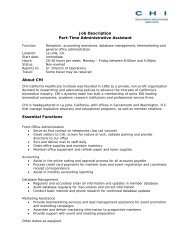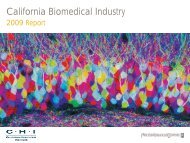California Biomedical Industry - California Healthcare Institute
California Biomedical Industry - California Healthcare Institute
California Biomedical Industry - California Healthcare Institute
You also want an ePaper? Increase the reach of your titles
YUMPU automatically turns print PDFs into web optimized ePapers that Google loves.
small biotechnology companies as theydevelop new therapies that could reducehealthcare costs as well as generate newjobs and stimulate the U.S. economy.“It’s not the space” that enables theyoung entrepreneurs to succeed, Kellysaid. “It’s that they talk to each other.”They offer one another advice andreferrals. They brainstorm on scientificquestions and hold one anotheraccountable for staying focused on theirgoals.Increasing the connectivity amongresearchers, clinicians and industryis one of Kelly’s personal missions.The QB3 administrative offices as wellas the UCSF facilities are located inMission Bay, a 303-acre neighborhoodin San Francisco. The city designated ita redevelopment project in 1998, andto date the university has completedand occupies six buildings there.Construction of the new UCSF MedicalCenter at Mission Bay, a significantcomponent in the $1.5 billion hospitalsystem planned for the site, isunderway. The community also includesresidential, restaurant and retail space,and Kelly trusts that the future willbring biomedical industry operations aswell.He envisions the site as “the academichealth center of the 21st century.”He said pulling in entrepreneursand investors will bridge the gapsbetween unmet medical needs and thecommercialization of breakthroughproducts to address them.“The notion of a physician andresearcher having a spontaneousconversation in an elevator andconceiving an idea for a new therapeuticagent is a fallacy,” Kelly said. Physiciansand scientists not only think differently,they are working at opposite ends ofcomplex puzzles. They need the privatesector to do the expensive and high riskproduct development work in between.In addition to locating the threegroups closer together, Kelly has ideasfor improving communications andfunctions among them as well. Oneis to change the university’s goals intechnology transfer from generatingmoney for the university to improvingsociety. Moving ideas out of academiclabs and into the private sector createsjobs, increases tax and sales revenues,and ensures better therapies andapproaches for public health.Second, Kelly said that society isnot served by viewing industry as avillain. Without investors and privatesector companies, ideas stagnate, jobopportunities are lost, and innovationflounders.Third, Kelly would like to see an effortamong researchers, clinicians andindustry to catalog society’s biomedicalneeds. “The major weakness ofacademia,” he said, “is that studentsand post-docs don’t know what societyneeds.” When they ask their professors,they are steered toward the professors’chosen areas of focus.“<strong>Industry</strong> and venture capitalists arevery good at identifying what the needsare,” Kelly said. “And clinicians knowwhat the needs in their specialties are.”He said turning young minds loose onthe list would speed innovation. Thosewho already had a discovery or deviceapplicable to a market need wouldbe positioned to solicit technologytransfer office assistance with patentapplications and out-licensing. Otherscould focus their research on addressingold needs in new ways, increasing therelevance of their work to public health.Working together, researchers,industry and clinicians could acceleratebiomedical innovation. And isn’t thatwhat the process of technology transferis all about?<strong>California</strong> <strong>Biomedical</strong> <strong>Industry</strong> 2011 Report | 83






